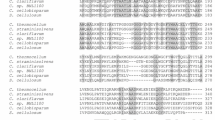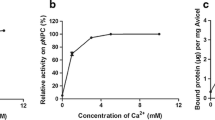Abstract
We previously isolated and reported a second species of the Saccharophagus genus, Saccharophagus sp. strain Myt-1. In the present study, a cellulase gene (celMytB) from the genomic DNA of Myt-1 was cloned and characterized. The DNA sequence fragment contained an open reading frame of 1,893 bp that encoded a protein of 631 amino acids with an estimated molecular mass of 66.8 kDa. The deduced protein, CelMytB, had a catalytic domain that contained a conserved signature sequence (VIYEIYNEPL) of glycosyl hydrolase family 5 and a CBM6 cellulose binding module. CelMytB showed optimal activity at 55 °C and pH 6.5, which is similar to the optimal temperature and pH profile of cel5H, an endoglucanase from the closely related S. degradans 2-40. However, the cellulase (degradation of soluble cellulose) and avicelase (degradation of crystalline cellulose) activities of CelMytB were about 3-fold and 100-fold higher, respectively, than the equivalent activities of cel5H. Moreover, CelMytB could degrade xylan. From the zymogram results, we speculated that the catalytic domain of CelMytB had high activity even without the cellulose binding module. The presence of some detergents stimulated the cellulase activity of CelMytB.




Similar content being viewed by others
References
Jarvis M (2003) Chemistry: cellulose stacks up. Nature 426:611–612
Jung YJ, Lee YS, Park IH, Chandra MS, Kim KK, Choi YL (2010) Molecular cloning, purification and characterization of thermostable β-1,3-1,4 glucanase from Bacillus subtilis A8-8. Indian J Biochem Biophys 47:203–210
Bhat MK (2000) Cellulases and related enzymes in biotechnology. Biotechnol Adv 18:355–383
Sun Y, Cheng J (2002) Hydrolysis of lignocellulosic materials for ethanol production: a review. Bioresour Technol 83:1–11
Lee YJ, Kim BK, Lee BH, Jo KI, Lee NK, Chung CH, Lee YC, Lee JW (2008) Purification and characterization of cellulase produced by Bacillus amyoliquefaciens DL-3 utilizing rice hull. Bioresour Technol 99:378–386
Lynd LR, Weimer PJ, van Zyl WH, Pretorius IS (2002) Microbial cellulose utilization: fundamentals and biotechnology. Microbiol Mol Biol Rev 66:506–577
Ng IS, Li CW, Yeh YF, Chen PT, Chir JL, Ma CH, Yu SM, Ho TH, Tong CG (2009) A novel endo-glucanase from the thermophilic bacterium Geobacillus sp. 70PC53 with high activity and stability over a broad range of temperatures. Extremophiles 13:425–435
Garsoux G, Lamotte J, Gerday C, Feller G (2004) Kinetic and structural optimization to catalysis at low temperatures in a psychrophilic cellulase from the Antarctic bacterium Pseudoalteromonas haloplanktis. Biochem J 384:247–253
Li X, Wang HL, Li T, Yu HY (2012) Purification and characterization of an organic solvent-tolerant alkaline cellulase from a halophilic isolate of Thalassobacillus. Biotechnol Lett 34:1531–1536
Vijayaraghavan P, Vincent SG (2012) Purification and characterization of carboxymethyl cellulase from Bacillus sp. isolated from a paddy field. Pol J Microbiol 61:51–55
Ekborg NA, Gonzalez JM, Howard MB, Taylor LE, Hutcheson SW, Weiner RM (2005) Saccharophagus degradans gen. nov., sp. nov., a versatile marine decomposer of complex polysaccharides. Int J Syst Evol Microbiol 55:1545–1549
Andrykovitch G, Marx I (1988) Isolation of a new polysaccharide-digesting bacterium from a salt marsh. Appl Environ Microbiol 54:1061–1062
González JM, Weiner RM (2000) Phylogenetic characterization of marine bacterium strain 2-40, a decomposer of complex polysaccharides. Int J Syst Evol Microbiol 50:831–834
Weiner RM, Taylor LE II, Henrissat B et al (2008) Complete genome sequence of the complex carbohydrate-degrading marine bacterium, Saccharophagus degradans strain 2-40 T. PLoS Genet 4:e1000087
Sakatoku A, Wakabayashi M, Tanaka Y, Tanaka D, Nakamura S (2012) Isolation of a novel Saccharophagus species (Myt-1) capable of degrading a variety of seaweeds and polysaccharides. MicrobiologyOpen 1:2–12
Tanaka D, Yoneda S, Yamashiro Y, Sakatoku A, Kayashima T, Yamakawa K, Nakamura S (2012) Characterization of a new cold-adapted lipase from Pseudomonas sp. TK-3. Appl Biochem Biotechnol 168:327–338
Laemmli UK (1970) Cleavage of structural proteins during the assembly of the head of bacteriophage T4. Nature 227:680–685
Schwarz WH, Bronnenmeier K, Gräbnitz F, Staudenbauer WL (1987) Activity staining of cellulases in polyacrylamide gels containing mixed linkage β-glucans. Anal Biochem 164:72–77
Ratanakhanokchai K, Kyu KL, Tanticharoen M (1999) Purification and properties of a xylan-binding endoxylanase from Alkaliphilic Bacillus sp. strain K-1. Appl Environ Microbiol 65:694–697
Nelson N (1994) A photometric adaptation of the Somogyi method for the determination of glucose. J Biol Chem 153:375–380
Somogyi M (1952) Notes on sugar determination. J Biol Chem 195:19–23
Ghose TK (1987) Measurement of cellulase activities. Pure Appl Chem 59:257–268
Ko JK, Jung MW, Kim KH, Choi IG (2009) Optimal production of a novel endo-acting beta-1,4-xylanase cloned from Saccharophagus degradans 2-40 into Escherichia coli BL21 (DE3). N Biotechnol 26:157–164
Watson BJ, Zhang H, Longmire AG, Moon YH, Hutcheson SW (2009) Processive endoglucanases mediate degradation of cellulose by Saccharophagus degradans. J Bacteriol 191:5697–5705
Gao Z, Ruan L, Chen X, Zhang Y, Xu X (2010) A novel salt-tolerant endo-beta-1,4-glucanase Cel5A in Vibrio sp. G21 isolated from mangrove soil. Appl Microbiol Biotechnol 87:1373–1382
Howard MB, Ekborg NA, Taylor LE, Hutcheson SW, Weiner RM (2004) Identification and analysis of polyserine linker domains in prokaryotic proteins with emphasis on the marine bacterium Microbulbifer degradans. Protein Sci 13:1422–1425
Badieyan S, Bevan DR, Zhang C (2012) Study and design of stability in GH5 cellulases. Biotechnol Bioeng 109:31–44
Asha BM, Revathi M, Yadav A, Sakthivel N (2012) Purification and characterization of a thermophilic cellulase from a novel cellulolytic strain, Paenibacillus barcinonensis. J Microbiol Biotechnol 22:1501–1509
Beg QK, Kapoor M, Mahajan L, Hoondal GS (2001) Microbial xylanases and their industrial applications: a review. Appl Microbiol Biotechnol 56:326–338
Kuhad RC, Gupta R, Singh A (2011) Microbial cellulases and their industrial applications. Enzym Res. doi:10.4061/2011/280696
Acknowledgments
This study was partly supported by grants from the Japan Society for the Promotion of Science (Grant-in Aid for JSPS Research Fellows No. 10085 (to AS).
Author information
Authors and Affiliations
Corresponding author
Rights and permissions
About this article
Cite this article
Sakatoku, A., Tanaka, D., Kamachi, H. et al. Cloning and Characterizing the Thermophilic and Detergent Stable Cellulase CelMytB from Saccharophagus sp. Myt-1. Indian J Microbiol 54, 20–26 (2014). https://doi.org/10.1007/s12088-013-0421-0
Received:
Accepted:
Published:
Issue Date:
DOI: https://doi.org/10.1007/s12088-013-0421-0




